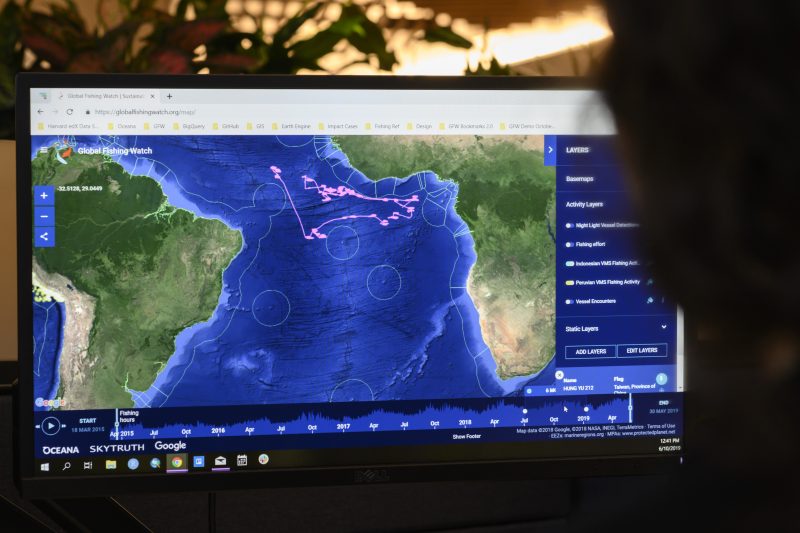NGO works as high seas sleuth to track illegal fishing
The web site Global Fishing Watch at the headquarters of the NGO Oceana in Washington (Eric BARADAT)
Washington (AFP) – From her desk in a building in downtown Washington, Lacey Malarky monitors fishing vessels that take advantage of the vastness of Earth’s oceans to cheat in the belief that no one is watching.
Malarky uses a website called Global Fishing Watch, which was launched by her employer, the NGO Oceana, with Google and a nonprofit called SkyTruth less than three years ago to trace where 70,000 fishing vessels have sailed since 2012.
The site analyzes the GPS signals emitted by these ships and plots them on a map to help people such as Malarky to determine if they have gone into a protected region, or are in fact working in an area that corresponds to the species of fish they say they are looking for.
Using artificial intelligence, Global Fishing Watch can even tell what kind of fishing technique a vessel is engaged in: trawling (a net that drags along the seabed); longlining (a line with baited hooks spaced at intervals) or purse seine fishing (using a net that hangs vertically and surrounds a school of fish).
Each method has its own its pace and trajectory and targets specific species.
“If you were to just do the track lines of these vessels, it’d be a pile of spaghetti on the map,” said Beth Lowell, deputy vice president for US campaigns with Oceana.
“The special sauce of Global Fishing Watch is that it takes that pile of spaghetti, and distills it down to where machine learning infers that it’s fishing,” she added.
Lowell added: “It’s definitely becoming harder to hide beyond the horizon.”
But there are still ways to evade detection. Ships have devices called an Automatic Identification System that manages their GPS signals. But these are not mandatory everywhere in the world for fishing vessels.
Countries have their own systems that are mandatory, but only Indonesia and Peru — to be joined soon by Chile — share their data with Global Fishing Watch.
– Policing the sea –
By way of example, the NGO on Thursday published a report tracing the movements of three ships that have a bad reputation.
The open sea can be used for forced labor, keeping crew members toiling for months and months, far from the eyes of any inspectors.
Such is probably the case of a ship called the Hung Yu 212, with a Taiwan flag. From 2015 to 2017, it was probably at sea for 20 months, according to GPS data examined by Malarky and her colleagues.
Oceana also points its finger at the South Korean-flagged Oyang 77. This ship does not have the rights to fish in waters governed by Argentina — up to 200 nautical miles from its coasts.
But from 2014 to 2019 it turned off its transponder 77 times when it was on the edge of or inside Argentina’s exclusive economic zone.
All signs are that it went to fish clandestinely in waters that were off limits to it, then turned its GPS back on when it returned to international waters. Its movements are obvious when analyzed over a long period.
The Argentine coast guard eventually caught the Oyang 77 in February of this year.
A third vessel, a refrigerated cargo ship called the Renown, illustrates how fish get laundered: fishermen with illegal catches transfer their booty to this kind of ship. GPS data help detect such handoffs.
“It is investigative work,” said Malarky.
Oceana wants authorities to use the website on a routine basis to target their port inspections. It is more than just watching over how fish stocks are managed, Oceana says.
“It’s really hard to do fisheries enforcement, because we don’t have the ability to have planes flying over the whole entire oceans and an observer on every vessel,” said Lowell.
“Oftentimes, it’s criminal enterprises that are making profits on evading fisheries laws or labor laws.”
Disclaimer: Validity of the above story is for 7 Days from original date of publishing. Source: AFP.


